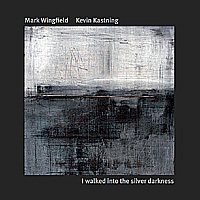 One
of the most prolific guitarists working in the U.S. today, Kevin
Kastning is truly a man of the world. Having recorded in 2010
with Hungarian guitarist Sándor Szabó—among his
many ongoing projects—Kastning has done it again, this time with
U.K. guitarist Mark Wingfield. The album project featuring
both Kastning and Wingfield, entitled I Walked Into The Silver
Darkness, is subtle, haunting and challenging music—all
at the same time. Of course, guitar experts cite influences from the
vast ECM catalog as musical signposts in Kastning’s approach
to sonic instrumental music, yet one could also mention U.K. guitar
pioneers, from Fred Frith to Allan Holdsworth, whose influences somehow
permeate into the mix on this album. As a musical accomplice, Wingfield
is an interesting choice for Kastning, considering the U.K. guitarist’s
last album, Sleeper Street was one of the most critically acclaimed
instrumental jazz fusion albums of 2010. In the spirit of ECM guitarists—Terje
Rypdal through John Abercrombie—Kastning and Wingfield, in their
own right, record music that is as challenging as it is indescribable.
Perhaps the beauty in their combined transcendental sound is in the
way the album is recorded, sounding like the musical equivalent of
a heavy mist against a grey skyline. Kastning’s custom built
acoustic guitars—including his recently acquired 14-string Contraguitar—sounds
almost organic compared to Wingfield’s sonic, horn like electric
guitar sounds. Commenting on the pairing in the Silver Darkness
CD liner notes, Kastning further explains ‘The blend of Mark’s
unique electric guitar voices with my extended range instruments and
unorthodox tunings created something very special. I don’t think
we were prepared for what happened.’ In his CD liner notes, Barry
Cleveland goes on at length about the ‘multidimensionality,
sonic automatic writing, swirling eddies of polytonalilty and serendipitous
harmonic confluences’...and so on. Sometimes instrumental music—rock
or classical—is so far ahead of the listening curve, that there’s
absolutely no accurate way to describe it. As far as describing the
music of I Walked Into The Silver Darkness, it’s kind
of like trying to describe a dream, or explaining how a cloud hangs
suspended or why the world turns around. The metaphysical sounding
I Walked Into The Silver Darkness just goes way beyond words
or mere explanations as far as reasons to listen.
One
of the most prolific guitarists working in the U.S. today, Kevin
Kastning is truly a man of the world. Having recorded in 2010
with Hungarian guitarist Sándor Szabó—among his
many ongoing projects—Kastning has done it again, this time with
U.K. guitarist Mark Wingfield. The album project featuring
both Kastning and Wingfield, entitled I Walked Into The Silver
Darkness, is subtle, haunting and challenging music—all
at the same time. Of course, guitar experts cite influences from the
vast ECM catalog as musical signposts in Kastning’s approach
to sonic instrumental music, yet one could also mention U.K. guitar
pioneers, from Fred Frith to Allan Holdsworth, whose influences somehow
permeate into the mix on this album. As a musical accomplice, Wingfield
is an interesting choice for Kastning, considering the U.K. guitarist’s
last album, Sleeper Street was one of the most critically acclaimed
instrumental jazz fusion albums of 2010. In the spirit of ECM guitarists—Terje
Rypdal through John Abercrombie—Kastning and Wingfield, in their
own right, record music that is as challenging as it is indescribable.
Perhaps the beauty in their combined transcendental sound is in the
way the album is recorded, sounding like the musical equivalent of
a heavy mist against a grey skyline. Kastning’s custom built
acoustic guitars—including his recently acquired 14-string Contraguitar—sounds
almost organic compared to Wingfield’s sonic, horn like electric
guitar sounds. Commenting on the pairing in the Silver Darkness
CD liner notes, Kastning further explains ‘The blend of Mark’s
unique electric guitar voices with my extended range instruments and
unorthodox tunings created something very special. I don’t think
we were prepared for what happened.’ In his CD liner notes, Barry
Cleveland goes on at length about the ‘multidimensionality,
sonic automatic writing, swirling eddies of polytonalilty and serendipitous
harmonic confluences’...and so on. Sometimes instrumental music—rock
or classical—is so far ahead of the listening curve, that there’s
absolutely no accurate way to describe it. As far as describing the
music of I Walked Into The Silver Darkness, it’s kind
of like trying to describe a dream, or explaining how a cloud hangs
suspended or why the world turns around. The metaphysical sounding
I Walked Into The Silver Darkness just goes way beyond words
or mere explanations as far as reasons to listen.
mwe3.com presents an interview
with
KEVIN KASTNING AND MARK WINGFIELD
mwe3: How did you two meet and how did that meeting lead to the recording
and production of I Walked Into The Silver Darkness and what
did you set out to achieve musically on the CD?
KK: There is an online magazine here in the US called Billy’s
Bunker, which is headed by Billy Sheppard. Billy has reviewed my albums
over the past few years, as well as Mark’s. Turns out he is a
huge fan of both Mark and I. In late 2009, Billy sent an email to
me stating that he had sent an album of mine to a British guitarist/composer
named Mark Wingfield, because he thought Mark and I should meet and
work together. Billy also sent some of Mark’s music to me. I
listened to Mark’s music, and was struck by its originality,
and the unique individuality of his playing. He had a distinct voice,
like a signature; as you know, that’s rare in the guitar world.
Mark contacted me via email, and we began a correspondence. We mailed
a few of our albums to each other. I liked his album Sleeper Street.
About this time, Mark asked if I’d like to do a recording
project with him. I’d not worked with an electric guitarist,
so I wasn’t sure what to say. I couldn’t quite grasp an
approach. As I was thinking about it, I had been listening to his
album Three Windows, which is a trio record for electric guitar,
saxophone, and harpsichord. Quite an unusual combination, and an uncommonly
good record. There was something in Three Windows that spoke
to me, and I knew that a duo project with Mark would work. Mark contacted
me again to let me know that he was going to be in the States late
in 2010, so we scheduled some studio dates. The first time we met
or played together were the sessions for what would become I walked
into the silver darkness.
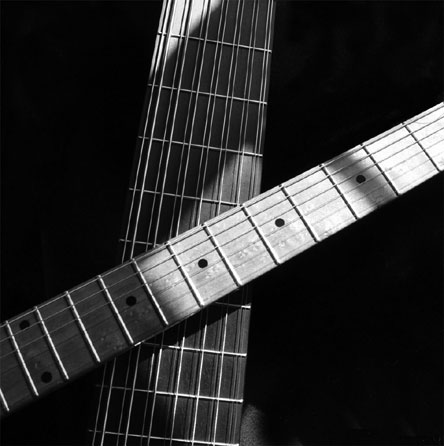 What
we set out to achieve wasn’t really discussed in advance; at
least not what we sought as an end goal. We discussed possible approaches.
We mentioned but rejected composing some pieces for the recordings.
I suggested that we utilize real-time composition for the entire project.
We talked about instruments we’d be using. Technical aspects
and logistics of the recording date were discussed. The recording
process and our working together took on an organic flow and a natural
life of its own. During the recording sessions, I really had no idea
of what we had on tape. I was very consumed by the process in the
moment. Until I heard the rough mixes, I didn’t know what we
had done.
What
we set out to achieve wasn’t really discussed in advance; at
least not what we sought as an end goal. We discussed possible approaches.
We mentioned but rejected composing some pieces for the recordings.
I suggested that we utilize real-time composition for the entire project.
We talked about instruments we’d be using. Technical aspects
and logistics of the recording date were discussed. The recording
process and our working together took on an organic flow and a natural
life of its own. During the recording sessions, I really had no idea
of what we had on tape. I was very consumed by the process in the
moment. Until I heard the rough mixes, I didn’t know what we
had done.
MW: I was introduced to Kevin by a mutual friend and journalist Billy
Sheppard, he runs a great album review site called Billy’s Bunker.
Billy emailed me an mp3 of a couple of tracks Kevin had recorded and
said I should hear this guy and he thought I'd really like it. I did,
it was some of the most original and engaging new music I'd heard
in a long time. I realized I was listening to someone who had created
a completely unique approach and sound world on the guitar. Listening
to it I really had the feeling that Kevin and I could do something
interesting together so I emailed him and we arranged a recording
session the next time I was in the US.
I don't think either of us had a preconceived idea of what we were
going to do when we got to the studio. Kevin suggested the idea that
we arrive with absolutely nothing planned or written and literally
compose in real time, with the record light on. I had played completely
spontaneous music live with my own band as well as with Iain Ballamy
and Thomas Stronen's Food. But I'd never recorded this sort of thing
before. So I was a little unsure what that would be like. We did talk
about our intention to make the improvisations sound as if they were
compositions, but that really was the only plan we had. However as
soon as we started playing it just felt completely natural, there
was an instant chemistry there.
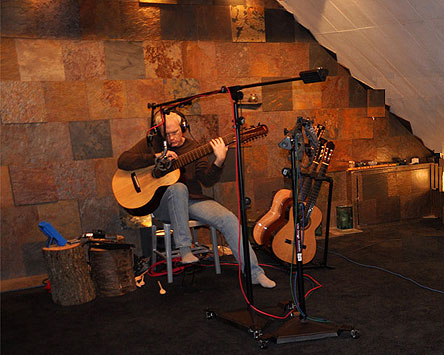 Kevin
is just so great at creating these intense and original sound worlds
that its difficult not to feel inspired playing with him. Perhaps
because we are both composers, we seemed to be able to sense where
each other were going. I would follow what Kevin was doing for a time
and then I would hear the next musical idea that would follow, as
if it was a composition and play that, then Kevin would follow me
for a time. Then at times we would both hear and move to a new place
simultaneously and the process would continue like that.
Kevin
is just so great at creating these intense and original sound worlds
that its difficult not to feel inspired playing with him. Perhaps
because we are both composers, we seemed to be able to sense where
each other were going. I would follow what Kevin was doing for a time
and then I would hear the next musical idea that would follow, as
if it was a composition and play that, then Kevin would follow me
for a time. Then at times we would both hear and move to a new place
simultaneously and the process would continue like that.
mwe3: What guitars are featured on I Walked Into The Silver Darkness
and how did you balance the contrasts in sound and dynamics between
Kevin’s extended range 12 and 14 string acoustic guitars with
Mark’s heavily modified electric guitars?
KK: I used four instruments on the recording sessions: the Daniel
Roberts Stringworks Kevin Kastning-Contraguitar, which is the 14-string
instrument. It has a tremendously wide range, from the lowest E on
a bass up to A in the alto register. The upper fingerboard extension
area above the 17th fret is fretless, so it is an incredibly versatile
and wide-ranging instrument. I have to take a minute and publicly
thank Daniel Roberts. He’s been an unseen partner in all that
I do for the past 11 or 12 years. He is an incredibly talented genius
luthier, and fortunately for me, fearless. I keep coming to him with
odder and weirder instruments, and he is always up for the challenge.
Dan and I speak the same language regarding instruments and luthiery,
so what he creates is not merely what I had in mind, but always surpasses
my expectations. The KK-Contraguitar was so successful for me that
right now, he’s finishing up the second KK-Contraguitar. One
of the Contras will stay in octave tuning, and the other will be in
my altered intervallic tunings, providing chord voicings of up to
14 notes. If it weren’t for Dan, I couldn’t realize much
of what I hear and compose. I walked into the silver darkness was
the KK-Contraguitar’s first appearance on an album; since then,
in 2011, I have used it on nine other album recording sessions. The
Contra is certainly my main instrument, and I used it on over half
of the tracks on silver darkness.
I also used my Cervantes Ramirez classical guitar, and the Santa Cruz
DKK-12 Extended Baritone guitar, which is tuned to F# (one whole step
above a bass). I used my Santa Cruz 12-string KK-Alto guitar on several
pieces. It’s tuned to A above E concert tuning, so it’s
a fourth above standard guitar tuning. However, none of the Alto pieces
were selected for “silver darkness.” I suspect the Alto
will turn up on the next record, though.
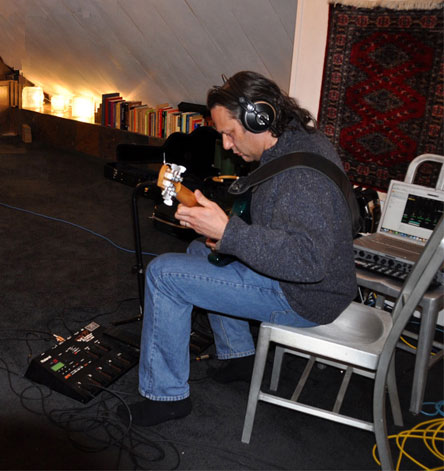 I
think the contrasts in our sound and dynamics happen in various ways;
one is that they are natural. My instruments are quite different from
Mark’s highly unique voice and voices, so even by both of us
playing a simultaneous note, there is quite a contrast. I think the
balance also happens naturally—in other words, there is never
a point in the recording sessions wherein I am consciously thinking
about balance. I do think about the composition as it is happening.
I suspect balance occurs organically within that process, as do issues
of texture. These are elements of the listening process that occurs
in real-time composing. The question of balance and contrast is an
interesting one.
I
think the contrasts in our sound and dynamics happen in various ways;
one is that they are natural. My instruments are quite different from
Mark’s highly unique voice and voices, so even by both of us
playing a simultaneous note, there is quite a contrast. I think the
balance also happens naturally—in other words, there is never
a point in the recording sessions wherein I am consciously thinking
about balance. I do think about the composition as it is happening.
I suspect balance occurs organically within that process, as do issues
of texture. These are elements of the listening process that occurs
in real-time composing. The question of balance and contrast is an
interesting one.
MW: I use a Patrick Eggle LA Plus. It’s entirely maple and one
of the first ones they made. I love the neck on this guitar. One of
the other things I like about it is the tremolo system which is one
of the best I've used and since the tremolo is such a central part
of my playing approach that's really important to me.
On almost every track of I Walked Into The Silver Darkness, my
guitar sound comes entirely from the Roland VG-88. I often read in
reviews that I'm using synth guitar, but actually I rarely use a synth.
When I do, it’s only placed way back in the mix behind the actual
guitar sound to just add texture. The track called “The Mirror
Of Here” is the only one on this album which uses a synth and
you can only just hear it mixed back behind the electric guitar sound.
 The
VG-88 uses the actual audio signal from the guitar and just alters
that. It allows you to choose and position virtual pickups, and choose
the guitar body type and size. From there its all conventional effects.
So its not a synth at all, it just lets you go that bit further in
choosing and shaping the tone of your guitar sound. What it does allow
is the processing of each string separately, hence the Roland hex
pickup which is just a magnetic pickup like any other except there's
a separate pickup for each string. This means you can get a cleaner,
more defined processing and you loose less detail in what you play
than most effects units, which is one of the things I love about the
VG-88. It also means that if you add a harmonizer effect, as I do
occasionally, it sounds kind of other worldly, but this is only because
it's so clean and has none of the micky-mouse artifacts of normal
pitch shifting. I use a harmonizer like this on the track called “The
Sharp Crucible of Autumn.”
The
VG-88 uses the actual audio signal from the guitar and just alters
that. It allows you to choose and position virtual pickups, and choose
the guitar body type and size. From there its all conventional effects.
So its not a synth at all, it just lets you go that bit further in
choosing and shaping the tone of your guitar sound. What it does allow
is the processing of each string separately, hence the Roland hex
pickup which is just a magnetic pickup like any other except there's
a separate pickup for each string. This means you can get a cleaner,
more defined processing and you loose less detail in what you play
than most effects units, which is one of the things I love about the
VG-88. It also means that if you add a harmonizer effect, as I do
occasionally, it sounds kind of other worldly, but this is only because
it's so clean and has none of the micky-mouse artifacts of normal
pitch shifting. I use a harmonizer like this on the track called “The
Sharp Crucible of Autumn.”
I think a lot of the unusualness people identify with my guitar sound
actually comes from how I approach playing the guitar. I always used
to listen to sax players where the tone and quality of every note
is different and think how limited the guitar is, you pick a note
or maybe hammer on or pull-off and that's about it for tone variation
from the playing point of view. But listening to players like Hendrix,
Beck and Rypdal, I realized that there was a lot more too it than
that. So I spent years working on different ways of sounding notes,
moving between them, and changing them as they sustain. This has lead
me to an approach where I'm often manipulating the tone of the notes
in a variety of unusual ways with my fingers.
I also trigger non-tonal samples from the guitar now and then like
on the track “Scattered Rain Of Sleep”. So I connect the
guitar to a sampler and map different notes to different sampled sounds.
I never use musical samples or sampled notes, I use nonmusical sounds
that for me create and atmosphere. On this track is was a mixture
of guitar triggered samples and non-tonal noises made by the guitar.
In terms of balancing the sounds, one of the things I like about the
VG-88 is that unlike a lot of guitar processors, it preserves a very
big dynamic range. Many conventional effects flatten all that out
and its more or less the same volume regardless how how hard you hit
the strings, though obviously the tone will be different. But the
VG-88's dynamic range means that there's a big difference in volume
between playing softer or harder. This means that balancing my sound
with Kevin's really wasn't an issue as I could move behind or in front
in terms of volume in a organic way as I played.
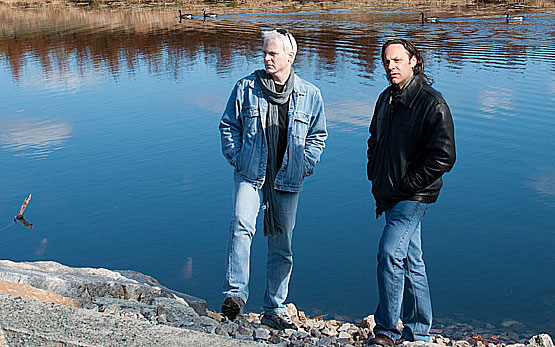 mwe3:
I understand you two just met again in November 2011 to record some
new material. Can you say something about the new music that was recently
recorded, and how it compares to I Walked Into The Silver Darkness
in style and scope?
mwe3:
I understand you two just met again in November 2011 to record some
new material. Can you say something about the new music that was recently
recorded, and how it compares to I Walked Into The Silver Darkness
in style and scope?
KK: Yes, we spent two days in the studio in November 2011. Essentially,
we picked up where we left off with the “silver darkness”
sessions from the previous year, but attempting to go beyond it, not
replicate it. We were using the same instruments, with a couple of
changes—because my DKK-12 was back at the shop in Santa Cruz
for a new neck, it wasn’t available for the sessions. I did use
my 6-string Santa Cruz model D on a few pieces, though. The Contraguitar
saw the lion’s share of the action. I also used the Santa Cruz
KK-Alto in various tunings, and the Cervantes classical.
We did most of the new compositions and tracks using real-time composition.
This time, we tried a couple of different approaches in addition to
that. Mark brought in a composition, and I brought in a couple of
compositions as well which I had written specifically for us. Those
pieces, though composed, were still pretty open and served as a framework
or compositional structure. Mark brought in a different set of samples
this time, and we worked with those; because these samples differed
from the first sessions, the resultant pieces were also different.
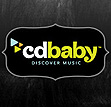 In
style, I wouldn’t say the new compositions are similar to the
first sessions, even though it’s still us and the pieces are
a product of that. However, we made a conscious decision at the outset
not to try to recreate anything from the first sessions, and to try
different approaches for these sessions. We didn’t want to make
I walked into the silver darkness II. I feel that our established
rapport and freedom allowed us to “breathe” more than on
the first sessions, and I think this may have had an impact on the
scope and depth of the pieces and the performances.
In
style, I wouldn’t say the new compositions are similar to the
first sessions, even though it’s still us and the pieces are
a product of that. However, we made a conscious decision at the outset
not to try to recreate anything from the first sessions, and to try
different approaches for these sessions. We didn’t want to make
I walked into the silver darkness II. I feel that our established
rapport and freedom allowed us to “breathe” more than on
the first sessions, and I think this may have had an impact on the
scope and depth of the pieces and the performances.
MW: I haven't heard the recordings yet but what I can say is that,
like our last recording session, it felt very good and I know lot
of really cool stuff happened. Like the last time, for most of the
session I was just totally absorbed in the music and the moment that
was happening and really not conscious of much outside of that. For
me that's always a really good sign. So I'm expecting another recording
as good as, though different from, I Walked Into The Silver Darkness.
Like that album, the new session was live in the studio with no
overdubs.
What was differed was on three tracks we used some new approaches
to impose limitations and directions. We had three compositions, each
of these dealt with one aspect of music only, leaving all other aspects
completely open to improvisation. So each of compositions dealt with
either timing, pitch or gesture, but never more than one of these
elements, everything else was left open to improvisation. Whether
these three will make the album, I'll have to wait until I've heard
them. All the other tracks we played were completely improvised, with
nothing written.
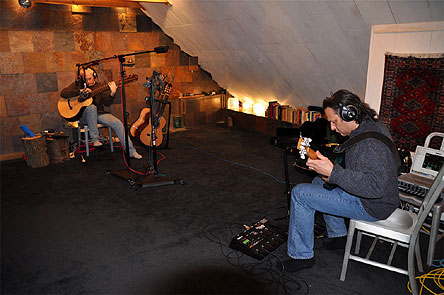 There
were some minor differences in the sounds I was using on the new recording.
I used a small amount of synth behind the main guitar sound on one
track on I Walked Into The Silver Darkness and I played nonmusical
samples on a couple of tracks, all the rest was just the audio signal
from my Patrick Eggle processed by the VG-88. In the new session I
didn't use any synth, but I did play some nonmusical samples on some
tracks and I used an infinite reverb on the laptop to sustain some
of the chords I was playing, but like the last album all the guitar
sounds were just Patrick Eggle through the VG-88.
There
were some minor differences in the sounds I was using on the new recording.
I used a small amount of synth behind the main guitar sound on one
track on I Walked Into The Silver Darkness and I played nonmusical
samples on a couple of tracks, all the rest was just the audio signal
from my Patrick Eggle processed by the VG-88. In the new session I
didn't use any synth, but I did play some nonmusical samples on some
tracks and I used an infinite reverb on the laptop to sustain some
of the chords I was playing, but like the last album all the guitar
sounds were just Patrick Eggle through the VG-88.
mwe3: I read something Sándor Szabó said about you playing
together and he compared it to the first acoustic and electric duets
of Ralph Towner and Jon Abercrombie on ECM. Do you think that’s
accurate and what musical signposts from the past did you draw upon
while constructing the I Walked Into The Silver Darkness CD?
 KK:
I appreciate Sándor making that analogy; coming from an artist
of his level it is high praise indeed. Sargasso Sea is a wonderful
album, and I’ve long been a fan of Ralph Towner. I don’t
hear that influence in the work of Mark and I, but I can see a kind
of lineage in that both Sargasso Sea and Silver darkness
are largely improvised duets between electric and acoustic guitar,
but that’s where the similarities end for me. It’s sad that
Towner and Abercrombie’s direction did not continue—I think
they only made one more record together. And since then, I’ve
not heard anyone else do an acoustic/electric duo until Mark and I.
I wasn’t consciously drawing upon anything in the past. Unconsciously,
I may have been drawing upon compositional influences ranging from
Machaut to Elliott Carter. Difficult to say; sometimes we don’t
know where our influences leave off and our true voice takes over.
KK:
I appreciate Sándor making that analogy; coming from an artist
of his level it is high praise indeed. Sargasso Sea is a wonderful
album, and I’ve long been a fan of Ralph Towner. I don’t
hear that influence in the work of Mark and I, but I can see a kind
of lineage in that both Sargasso Sea and Silver darkness
are largely improvised duets between electric and acoustic guitar,
but that’s where the similarities end for me. It’s sad that
Towner and Abercrombie’s direction did not continue—I think
they only made one more record together. And since then, I’ve
not heard anyone else do an acoustic/electric duo until Mark and I.
I wasn’t consciously drawing upon anything in the past. Unconsciously,
I may have been drawing upon compositional influences ranging from
Machaut to Elliott Carter. Difficult to say; sometimes we don’t
know where our influences leave off and our true voice takes over.
MW: Sándor is a great guitar player and musician so I'm always
interested in what he has to say and honored that he compares what
Kevin and I did to what Towner and Jon Abercrombie did. I love the
album Sargasso Sea which Towner and Abercrombie did together.
I don't hear much if anything in common in terms of their musical
world and the musical world Kevin and I explored in I Walked Into
The Silver Darkness. However, I can see other similarities. We
are playing duets with acoustic and electric. It's a very improvised
musical setting, in our case entirely improvised. The musical format
is not a conventional one, it doesn't fall neatly into a predetermined
genre, and our sound world does draw on some classical influence as
well as jazz. The same could be said of the Towner and Abercrombie
collaborations. In a sense I suppose you could say we are extending
that tradition. So from that point of view I do agree with Sándor.
mwe3: What are some of the musical activities and other recording
plans coming up for both of you in 2012?
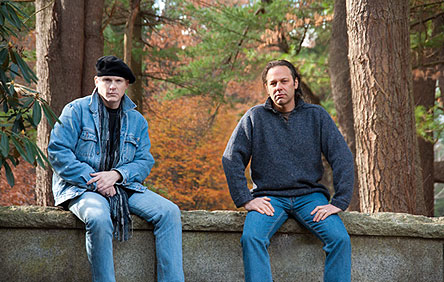 KK:
So far for 2012, I have five album releases scheduled—all duo
recordings. A January release with saxophonist/flautist Carl Clements.
Carl is a wonderful composer and musician; we’ve played together
for over 25 years, but this is our first duo recording. In March,
an album release with bass virtuoso Michael Manring. I think this
will be a pretty different album for both Michael and I, and I am
very excited about it. We both reached out into new directions on
it. The new record of Mark and I should be out around June. After
that is an album with Belgian lutenist Gilbert Isbin. Gilbert is entirely
unique in that he plays lute, but he’s utilizing it in a 21st-century
way with very modern harmonic approaches. Lute and Contraguitar makes
for a wondrous combination! In late 2011, a new record of Sandor Szabo
and I—this one was recorded on-location in Europe on a stop on
the 2009 tour. I have a record in the can with guitarist Alex De Grassi
which we recorded in March 2011. That will be quite a different project
for both Alex and I, and we are both looking forward to its release.
However, that one doesn’t yet have a release date, but should
be in 2012. In March, I am back in Europe for a tour with Sandor and
percussion artist Balazs Major. My next record is released December
13, 2011; it’s a trio record of Sandor, Balazs, and myself. So
the tour will be in support of that record. And we will take a day
or two out of the tour dates for recording dates. I have plans to
meet up with Mark at Bluebird Studios just outside Dublin, Ireland
while I’m over there for the tour—we’ll be tracking
a new album. I have recording dates on the horizon with cellist David
Darling. I am very much looking forward to that! There are some concerts
being scheduled in the US for Michael Manring and me for late 2012
and into 2013. Gilbert asked if I’d do some concerts with him
in Belgium after our record is out, and I look forward to that. Carl
and I will do some small concerts this year—last time we did
a concert together was in May 2010 in New York City. And I will be
attempting to complete the recording of my first solo album in 2012.
And Dan Roberts and I are doing a new one-of-a-kind multi-string instrument
in 2012. So it’s looking like a fun year for me.
KK:
So far for 2012, I have five album releases scheduled—all duo
recordings. A January release with saxophonist/flautist Carl Clements.
Carl is a wonderful composer and musician; we’ve played together
for over 25 years, but this is our first duo recording. In March,
an album release with bass virtuoso Michael Manring. I think this
will be a pretty different album for both Michael and I, and I am
very excited about it. We both reached out into new directions on
it. The new record of Mark and I should be out around June. After
that is an album with Belgian lutenist Gilbert Isbin. Gilbert is entirely
unique in that he plays lute, but he’s utilizing it in a 21st-century
way with very modern harmonic approaches. Lute and Contraguitar makes
for a wondrous combination! In late 2011, a new record of Sandor Szabo
and I—this one was recorded on-location in Europe on a stop on
the 2009 tour. I have a record in the can with guitarist Alex De Grassi
which we recorded in March 2011. That will be quite a different project
for both Alex and I, and we are both looking forward to its release.
However, that one doesn’t yet have a release date, but should
be in 2012. In March, I am back in Europe for a tour with Sandor and
percussion artist Balazs Major. My next record is released December
13, 2011; it’s a trio record of Sandor, Balazs, and myself. So
the tour will be in support of that record. And we will take a day
or two out of the tour dates for recording dates. I have plans to
meet up with Mark at Bluebird Studios just outside Dublin, Ireland
while I’m over there for the tour—we’ll be tracking
a new album. I have recording dates on the horizon with cellist David
Darling. I am very much looking forward to that! There are some concerts
being scheduled in the US for Michael Manring and me for late 2012
and into 2013. Gilbert asked if I’d do some concerts with him
in Belgium after our record is out, and I look forward to that. Carl
and I will do some small concerts this year—last time we did
a concert together was in May 2010 in New York City. And I will be
attempting to complete the recording of my first solo album in 2012.
And Dan Roberts and I are doing a new one-of-a-kind multi-string instrument
in 2012. So it’s looking like a fun year for me.
 MW:
I am currently recording an album with Swiss keyboardist and composer
René von Grünig and ECM artist Iain Ballamy on sax. Its
quite an ambitious album which combines composed elements which are
at times very melodic, at others dark and almost orchestral with a
lot of improvisation throughout. Iain and I take the melody lines
and most of the soloing along with René who also provides much
of the chordal content and there's great rhythmic momentum from drummer
Andi Motz and lyrical warmth from Yaron Stavi on bass. I'm pretty
excited about this album which is nearing completion. Early in 2012
I will be recording another album with Iain Ballamy which will be
just the two of us but will also involve some electronic textures
and samples. Kevin and I have another recording date scheduled for
March this time in Ireland, and then I have trio album planned with
drummer Asaf Sirkis and bassist Yaron Stavi. In June I have two pieces
being performed at the Kings Place Concert Hall in London which will
launch the start of a new recording project with Jane Chapman and
then I have various other composing commitments so it’s going
to be a busy year for me.
MW:
I am currently recording an album with Swiss keyboardist and composer
René von Grünig and ECM artist Iain Ballamy on sax. Its
quite an ambitious album which combines composed elements which are
at times very melodic, at others dark and almost orchestral with a
lot of improvisation throughout. Iain and I take the melody lines
and most of the soloing along with René who also provides much
of the chordal content and there's great rhythmic momentum from drummer
Andi Motz and lyrical warmth from Yaron Stavi on bass. I'm pretty
excited about this album which is nearing completion. Early in 2012
I will be recording another album with Iain Ballamy which will be
just the two of us but will also involve some electronic textures
and samples. Kevin and I have another recording date scheduled for
March this time in Ireland, and then I have trio album planned with
drummer Asaf Sirkis and bassist Yaron Stavi. In June I have two pieces
being performed at the Kings Place Concert Hall in London which will
launch the start of a new recording project with Jane Chapman and
then I have various other composing commitments so it’s going
to be a busy year for me.
Thanks to Kevin Kastning @ www.KevinKastning.com
and Mark Wingfield @ www.MarkWingfield.com



